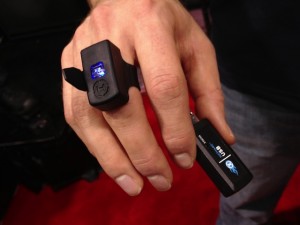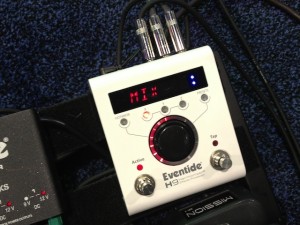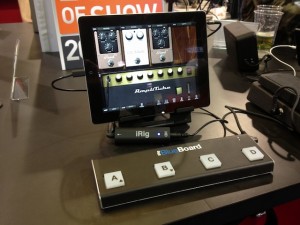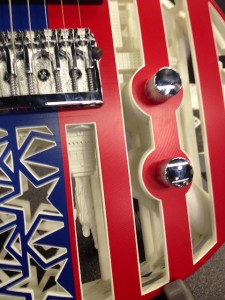This first installment of my 2013 NAMM report focuses on products for the digital guitarist. In the coming days I’ll be doing posts on analog amps, guitar, stompboxes, and accessories. (But maybe not as quickly as I’d like, because I’ve also got to cover MacWorld in San Francisco this weekend.) This is cross-posted from Create Digital Music, one of the few music sites I visit every frickin’ day.

Source Audio’s Hot Hand USB wireless controller.
We guitarists tend to be a technologically conservative bunch, yet there was no shortage of forward-looking products at NAMM 2013.
Not that everyone was looking in the same direction. Guitar processors are getting smarter, but they’re doing so in different ways. Are we entering an era when every guitar, amp, and pedal in our effect chain will boast powerful processors and a dedicated editing environment? Or will we just simply centralize everything in some future i-device? (I suspect that latter, and tend to think that smart pedals and smart amps represent an evolutionary cul-de-sac. But that cul-de-sac might be a real nice place to hang out for a couple of years.)

Eventide’s H9 can play all the sounds from the company’s software-intensive stompboxes, and you can edit and control them wirelessly.
One release I found particularly telling was Eventide’s H9, the latest addition to the company’s software-intensive stompbox line. The H9 has few new sounds, but can run all the DSP algorithms from Eventide’s other guitar stompboxes. The $499 box will ship late this quarter, preloaded with 9 of Eventide’s 43 current algorithms. Players hungry for more will be able to purchase them а la carte from an online store. (Eventide hasn’t yet finalized the add-on pricing.) The H9 also includes a handsome and full-featured iOS app for editing and managing patches via Bluetooth. There are no current plans to release an editor for OSX or Windows.
On the other hand, TC Electronic announced TonePrint Editor for Macs and PCs, but not iOS. This software editor will let users create and manage sounds for TC’s seven TonePrint-enabled pedals. Judging by the pre-release screenshots, the Editor is a fairly deep plug-in-style interface that can tweak far more parameters than might be accessible via the stompboxes’ knobs. (However, there aren’t yet any TonePrint-capable drive/distortion/fuzz effects — just reverb, delay, and modulation devices.)
Digital modeling amps are also advancing. I’ve heard raves about about the revamped modeling software in Fractal Audio’s Axe-Fx II, and representatives from several guitar and guitar parts companies told me that the adoption rate is phenomenal, particularly among young metal players. A newer rival, the Kemper Profiler, adds the ability to model any amp via an integrated signal generator and automated measuring/modeling tools. (A Kemper rep I spoke with insisted this is not an impulse-response process, but allowed that the device only measures an amp in a single, static state. It does not, for example, mimic the response of a particular amp’s tone or gain controls. All profiled amps get routed through a single EQ section.) New for 2013 is the Kemper Profiler Rack, a two-rack-space amp head, available with and without an integrated power amp.
 You could scarcely turn around without running into some new iOS-inspired product. There was also a seemingly endless supply of iPhone and iPad clamps, stands, and brackets from many manufacturers. IK Multimedia previewed their upcoming BlueBoard, a small, simple Bluetooth MIDI controller with four assignable footswitches, plus two 1/4” inputs for connecting continuous controllers (not included). IKM also demoed iLoud, a compact 40-watt RMS powered stereo speaker, and the iLoud MINI, an even tinier 12-watt version.
You could scarcely turn around without running into some new iOS-inspired product. There was also a seemingly endless supply of iPhone and iPad clamps, stands, and brackets from many manufacturers. IK Multimedia previewed their upcoming BlueBoard, a small, simple Bluetooth MIDI controller with four assignable footswitches, plus two 1/4” inputs for connecting continuous controllers (not included). IKM also demoed iLoud, a compact 40-watt RMS powered stereo speaker, and the iLoud MINI, an even tinier 12-watt version.
I had the pleasure of speaking with Olaf Diegel of New Zealand’s ODD, the man behind those radical 3D-printed guitars that have set the guitar forums ablaze. Each of Diegel’s instruments is a virtuoso display of this emerging technology. For example, he showcased an American flag-themed guitar with an intricately crafted NYC skyline visible through the body’s holes. I also had the chance to play one of Olaf’s $3,000 guitars. Diegel is more a 3D-printing visionary than a luthier, and while his instruments sound decent, they don’t offer the tone or refinement you’d expect from a $3K axe. But someday soon a great luthier will collaborate with a 3D print specialist, and awesome things will happen. (Though I wager we’ll see bitchin’ 3D-printed parts and accessories before we see a truly bitchin’ printed guitar.)

One of ODD’s 3D-printed guitars. God may or may not be in the details, but Lady Liberty certainly is!
At least two MIDI guitar products drew steady crowds. Neither is an entirely new idea, but the technology that surrounds them has evolved to such a degree that they may finally make a serious splash. For the second year running, Fishman showcased their TriplePlay MIDI Guitar Controller. (And it’s still not shipping, though it’s promised before the end of this quarter). TriplePlay is a smart update of the old hexaphonic pickup idea. Unlike the earlier Roland and Yamaha systems, TriplePlay transmits MIDI data wirelessly to a dongle-sized USB receiver. This means a) no clunky 13-pin cable, b) no rack-mounted processor, c) no need to rely on cheesy factory patches, and d) a relatively modest price (probably just north of $300). [Disclosure: Fishman is one of my clients, and I’ll be demoing TriplePlay at MacWorld in San Francisco this weekend.]
Also coming soon is Source Audio’s Hot Hand USB. Players wear the Hot Hand controller on their finger like an oversized ring. The unit’s internal accelerometer generates MIDI info that can be routed to various effect parameters. (For example, you might control a filter-cutoff frequency with the wave of a hand.) The original Hot Hand worked only with Source’s own stompboxes, but the upcoming USB version deploys a wireless, dongle-sized receiver much like the one used in TriplePlay, so you’ll be able to route the accelerometer info to any destination.
These last two items gave me chance to chat with two important digital guitarists. Adrian Belew was scoping out TriplePlay. And I loved hanging out with Derek Song, the 23-year-old whiz kid whose band, Pinn Panelle, is close to racking up its nine millionth view with their realtime cover version of Skrillex’s “Scary Monsters and Nice Sprites.” The Hot Hand appears prominently in the viral hit, as does the qwerty keyboard mounted behind the bridge of Derek’s guitar, which he uses to wirelessly control his software-intensive tones. Derek developed this and other controllers on his own, and he builds custom processors using Max/MSP, so sadly, these tools were not displayed at NAMM. They are, in the words of countless 2 A.M. informercials, “not available in stores.”
I scored a cool interview with Derek, which I’ll be posting here soon. In the meantime, check this shit out enjoy this extraordinary performance:








Was there another MIDI guitar system you were going to describe?
I think single function pedals are going to be around for a long time, if for no other reason simplicity. Whether they are analog or digital at heart depends mostly on the resources, ingenuity, and marketing strategy of the designers.
I had this thought a few days ago of Pete Townshend ramming his guitar’s headstock into his iPad, followed by Jimi Hendrix setting his laptop on fire, and, uhhh…. just doesn’t seem right to me.
Just read a review of the TC electronics Ditto looper neat little thing 1 knob and 1 switch-mini footprint on your board. Bigger is better , smaller is smarter ?
Yes — I wanted to try one of those at the show, but the crowds were a little too intense. 🙁
I’m holding out for the Bluetooth bio-feedback headband for looper control.
I have a Digitech JamMan, which I’ve found to be OK, esp with the external up/down footswitch. I just get some basic idea in there and then eventually transfer it over to my DAW using USB.
I also have a Line6 M9 and tried to use the looper once playing with a drummer. It didn’t work very well and I found out later (after the drummer shunned me) that the Line6 pushbuttons are really unreliable. I can echo (cough) that after buying a Flextone combo with a busted footswitch (which I repaired with a short piece of lollipop stick and epoxy). Back to the M9, it seems to respond ok if you press the button slowly, but if you stomp on it hard (it’s a footswitch, right?) it does not.
Our genial host is a master of live looping. It’s a tightrope act.
The number one mod for Line6 anything is replacing switches.I have issues just getting 2 parts to match time with a loop,much less real time and live ?
Wow. That was a great cover. Can’t wait to check out the interview with Derek Song. Hopefully it will give up some deets on how he uses this very intriguing Max/MSP! Glad to happen upon your awesome site, Mr. Gore. Been a fan of your journalism since the Guitar Player days. You helped break some pretty cool artists, imho, by covering them in a national forum. Still digging Buckethead, especially. And I may go see NIN again if Adrian Belew is indeed making the tour!! :thumbup: :thumbup:
Hey Robert! Hi from MacWorld. And thanks for the kind words. Yeah, Derek is a pretty impressive dude. I think we’ll be hearing a lot more from him.